So much has happened since I last posted that it’s hard to know where to begin in terms of the strange new world we are living in at present.
My own journey to isolation started in Yorkshire. At the time it seemed safe to travel and to go ahead with our two-week holiday, but that weekend everything changed in terms of both the political and public attitude to the Coronavirus pandemic. Northern railway stations such as Leeds and York, usually so crowded you had to fight your way to the platforms, were completely deserted. Trains were cancelled as drivers self-isolated. We made it to Ilkley and walked on the Moors as much as we could before deciding it would be better to cut our losses and come home. Five days later, safely home in Norfolk, we were in Lockdown.

Ilkley was a great little town, the High Street flanked with blossoming trees and the moors looming at the end of the road. Darwin was a fan of this area and would surely have loved its prehistory. Once on the moors it does feel like a different world, there are stones marked with neolithic carvings (see the Swastika Stone below) scattered all over the rough terrain, craggy brooks and a rather enigmatic stone circle called The Twelve Apostles which might, or might not, be ancient. The views from every point are sweeping, one way to Leeds, the other way to the Three Peaks – the weather was mockingly good throughout as we started planning our return.
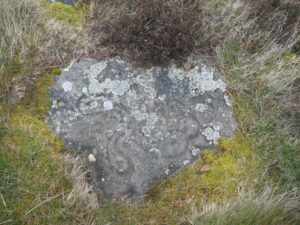
There are far worse places to be locked down than East Runton. We are very fortunate that our favourite local walks are all within the somewhat confused remit of one-a-day exercise as they all start the minute we step out of our front door. It’s a time to appreciate the little things and to celebrate what we have access to. I’m a Skype convert and have chatted to friends in Denmark and The Netherlands as well as having a virtual glass of wine with my best friend in London a couple of times a week.
It’s a time to be inventive with food too – infrequent supermarket trips mean there’s plenty of opportunity to delve into the back of the storecupboard and transform that slightly out of date chickpea flour into onion bhajis and calentica (a kind of North African pancake mix which I used to have a lot when I was in Paris in the 80s). It might be time to try and make nettle soup too – we have so many locally and it’s been on my radar for a while!

Then there are the projects. We’ll be working our way through our DVD box set of Wagner’s The Ring – my favourite opera(s). I can’t describe the feeling when the first notes of Das Rheingold rumble out – primeval. Foolish actions almost leading to the end of the world – perhaps not such a strange choice… Chris has dusted off a 10-hour History of Reggae from Mento to Lover’s Rock by Linton Kwesi Johnson so I might be a far better bet in pub quizzes from now on! I rarely buy hardbacks but splashed out on Hilary Mantel’s The Mirror and the Light having so much enjoyed the first two books of her Cromwell Trilogy. As a writer I am in awe at how she makes the characters’ speak so naturally, and how she does this without using quote marks but the reader is never confused. I’ve also bought Atwood’s The Testaments and two Ada Limón poetry collections Bright Dead Things and The Carrying – beautifully accessible poetry. And Chen Chen’s When I Grow Up I Want to be a List of Further Possibilities. Check out both these poets at the wonderful Poetry Foundation website:
https://www.poetryfoundation.org/poets/ada-limon
https://www.poetryfoundation.org/poets/chen-chen
So, now to the sheep and the goats! One of my previous blogposts featured the gorgeous Kashmiri goats of Great Orme, the rocky outcrop which looms into the sea and starts in the town of Llandudno. Well, these goats are now international stars – a YouTube sensation. Since the lockdown they have started to come into Llandudno and run riot. They always ventured down in the past but now there are no humans to chase them back up to the hills. Check out this article with accompanying video.
One of the most interesting things about the global lockdown has been the effect on nature. I’ve been reading about Malthus, the nineteenth century economist and demographer. His theory is that if one species becomes too dominant then nature will find a way of redressing the balance. As we stay local for a few weeks and consume and travel less, there’s a neat bit of rewilding going on – less pollution, more birdsong. There have been lots of news items about nature taking back Venice as the waterways become clearer.
There’s a very interesting writing project called Postcards from Malthusia which might be of interest:
https://newbootsandpantisocracies.wordpress.com/
Nature has always been prevalent on our favourite local walk. It only takes 40 minutes but at the moment, in terms of what you can see in the Springtime, it feels epic!
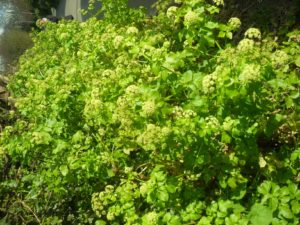
The walk starts with a hedgerow full of glowing lime-green alexanders. These edible plants were introduced to the UK by the Romans and known as the “pot plants of Alexandria” – every bit of the plant is edible and it’s often known as Roman celery. It has a beautiful sweet scent, a bit like elderflower, and a tangy sap. It’s too pretty to forage, but you never know…
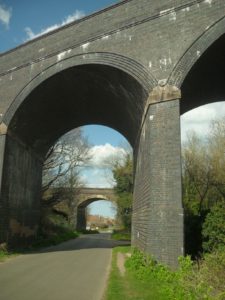
Then, under the double-viaduct that separates the village into Top Common and Lower Common. It was built in 1902 to bring holidaymakers to the coast from all parts of the country.
At this stage we always do a quick double-check to see if there are still nine classic white farmyard geese hanging out like bored teenagers on the green (there were twelve when we moved here).
Then on to Manor Farm which is just like the kind of farm you’d have as a kid, a little bit of everything – donkeys, sheep, lambs, hens, a cockerel, Muscovy ducks, sometimes goats, the occasional horse.

Up the road to check on the lambs. In just a few days they have become more solid, less leggy and much calmer, less inclined to do their Harrier Jump Jet VSTOL (Vertical Short Take Off and Landings) leaps. I can’t help thinking about military planes when I see these lambs. Well, I do come from Kingston-upon-Thames where British Aerospace had their factory and it was almost mandatory to work there for a bit – I temped there for two summers and both my then boyfriend and my brother did their apprenticeships there.
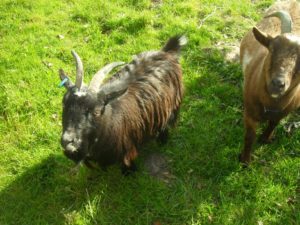 Down the green lane to the pygmy goats. These are hilarious. I seem to have perfected some kind of fake Swiss yipping yodel which brings them running, bells clanking and I can get them to follow me along the fence line to the next gate. The goat whisperer!
Down the green lane to the pygmy goats. These are hilarious. I seem to have perfected some kind of fake Swiss yipping yodel which brings them running, bells clanking and I can get them to follow me along the fence line to the next gate. The goat whisperer!
Then along the lane with views to Cromer Ridge and Incleborough Hill to the crossroads and back towards the village via the Big House and Britain’s first Montessori School. Quick recount of the geese, back under the viaduct and home. It’s a lovely walk, never tedious, always full of wildlife (buzzards wheeling, a green woodpecker calling) and wildflowers (the celandine are particularly beautiful at the moment).
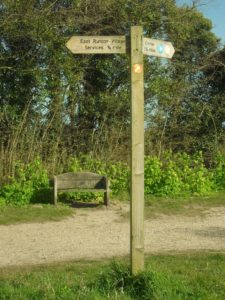
On a pre-lockdown walk in February we took a friend up the Hill to see the Bagot goats who were overwintering here before being let loose on Cromer cliffs to do their bit as live lawnmowers. I gather they are now self-isolating on Salthouse Heath but hopefully there’ll be a bit of Summer for us all, with a bit of the Old Normal seeping back into our lives. Until then, stay safe everyone…
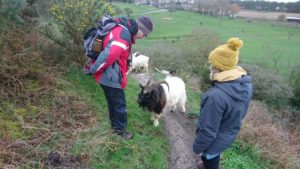
I enjoyed reading this very much, and picturing you on your walk.
I also look forward to reading Mantel’s latest work, and thank you for the poetry recommendation and sharing the link to the poetry foundation.
Best wishes from Glarus, where spring almost feels like summer, only on stand-by.
Lovely blog Sue and lovely photos. Talking of nature moving in I had a Muntjac deer in my garden last week – now I know what ate my tulips! (Subject of one of my haiku) Interesting how they go for some things not others but then why not? So do we!
Thanks Sue for the read, keep sane as well as safe 🙂
Alexanders are delicious if you get the young fat budding shoots early on low down before they become tall and leggy. They snap off. If you they don’t snap you know they are too old. Steam for a minute.